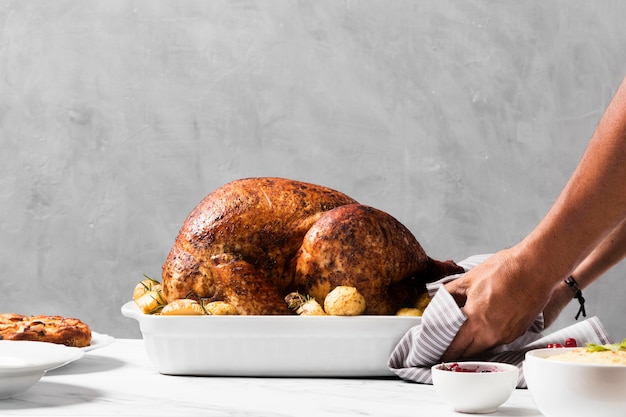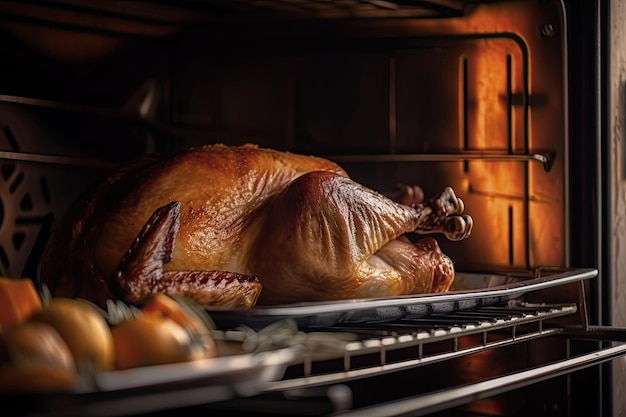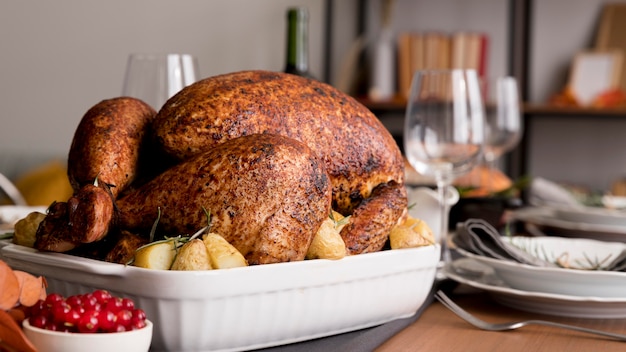(Part 1) The Basics: Understanding Cornish Hens

I’ve always been a fan of Cornish hens because of their tender, juicy meat. They’re incredibly versatile too. You can roast them whole, stuff them with herbs and flavourings, or even break them down and cook them in parts. The choice is yours!
Knowing Your Oven's Personality
Before diving into the specifics of cooking times, there's one crucial detail you need to keep in mind: your oven. Ovens can be a bit quirky, you know, when it comes to temperature and how they distribute heat. If you're unsure about your oven's little quirks, it's always a good idea to consult its manual or do a quick search online for your specific model.Temperature: The Golden Rule
The ideal temperature for roasting a Cornish hen is around 350°F (175°C). This temperature helps ensure the hen cooks evenly and doesn’t dry out. But, as I mentioned, ovens can be a bit unpredictable. If you find yours runs a little hot, you might need to lower the temperature by 25°F (14°C) to prevent overcooking.(Part 2) Preparing the Cornish Hen: A Step-by-Step Guide

1. Pat It Dry:
First things first, give that Cornish hen a good pat dry with some kitchen paper. This helps prevent steam build-up during roasting, which allows the skin to become gloriously crispy.2. Season It Up: A Symphony of Flavours:
Next, we're going to season our little bird. This is where you can really let your creativity run wild. A classic combination is salt and black pepper. But if you’re feeling adventurous, you could try adding herbs like rosemary, thyme, or oregano. A touch of garlic powder or paprika adds a fantastic depth of flavour as well.3. Stuff It (Optional): A Burst of Flavor:
Stuffing is a fantastic way to add extra flavour and moisture to your Cornish hen. You can go with traditional bread-based stuffing or create a delicious herb and vegetable stuffing. Just make sure the stuffing isn’t packed too tightly. You want it to cook evenly and not prevent the hen from browning nicely.4. Tie It Up: Ensuring Even Cooking:
If you're roasting your Cornish hen whole, tie the legs together with kitchen twine. This helps keep the legs from splaying out during cooking, ensuring even browning.(Part 3) Cooking Time: The Key to Perfection

General Cooking Time:
A general rule of thumb is to roast a Cornish hen for about 45 to 55 minutes at 350°F (175°C). This time is for a whole Cornish hen. If you're cooking a stuffed hen, you'll want to add an extra 10-15 minutes to ensure the stuffing is cooked through.Important Tip:
Remember to check the internal temperature of the hen to ensure it's cooked through. The safe internal temperature for poultry is 165°F (74°C). You can use a meat thermometer to check the temperature in the thickest part of the thigh.Check for Doneness:
When the hen is cooked through, the juices should run clear when you pierce the thickest part of the thigh with a fork. The skin should also be golden brown and crispy.Resting Time:
Once the hen is cooked, let it rest for about 10 minutes before carving. This allows the juices to redistribute, resulting in a more succulent and juicy bird.(Part 4) Creating a Delicious Roast: Elevate Your Cornish Hen to New Heights
Now let's dive into some tips and tricks to make your roasted cornish hen a real star on the dinner table.1. Basting:
Basting is a great way to keep your Cornish hen moist and add extra flavour. You can use a mixture of butter, herbs, and lemon juice for basting. Baste the hen every 15 minutes or so during cooking.2. Roasting Vegetables: A Symphony of Flavours:
Why not add some extra flavour and goodness to your meal by roasting vegetables alongside your hen? Root vegetables like carrots, potatoes, and parsnips are perfect accompaniments. Simply toss them in olive oil, salt, and pepper, and spread them around the hen.3. Make a Gravy:
I always love a good gravy with my roasted Cornish hen. You can make a delicious gravy using the pan drippings. Just strain the pan juices, deglaze the pan with a little wine or stock, and thicken it with cornstarch or flour.(Part 5) cornish hen recipes: Tried and True Favourites
You know, I've got a whole arsenal of cornish hen recipes up my sleeve. Here are a couple of my absolute favourites:1. Classic Roasted Cornish Hen:
1 Cornish hen 1 tablespoon olive oil 1 teaspoon salt 1/2 teaspoon black pepper 1/4 teaspoon dried thymePreheat oven to 350°F (175°C). Pat the hen dry with paper towels. Rub the hen with olive oil, salt, pepper, and thyme. Roast for 45-55 minutes, or until the internal temperature reaches 165°F (74°C).
2. Honey-Lemon Glazed Cornish Hen:
1 Cornish hen 1 tablespoon olive oil 1 teaspoon salt 1/2 teaspoon black pepper 1 tablespoon honey 1 tablespoon lemon juice 1/4 teaspoon dried rosemaryPreheat oven to 350°F (175°C). Pat the hen dry with paper towels. Rub the hen with olive oil, salt, and pepper. In a small bowl, combine the honey, lemon juice, and rosemary. Pour the glaze over the hen. Roast for 45-55 minutes, basting with the glaze every 15 minutes.
(Part 6) Cooking Times: Variations for Different Weights
I know everyone's got different preferences when it comes to their Cornish hen. Some folks love them juicy and tender, while others like them with a bit of crispy skin. So, let's take a look at how cooking time varies depending on the weight of your Cornish hen.Here's a table that breaks down cooking times based on the weight of the hen. Remember, these are just guidelines, so always check the internal temperature to ensure it's cooked through.
| Hen Weight (lbs) | Cooking Time (minutes) |
|---|---|
| 1 lb | 45-50 |
| 1.25 lbs | 50-55 |
| 1.5 lbs | 55-60 |
(Part 7) Don't Forget the Sides!
Okay, so now that you've got your perfect cornish hen, it's time to think about those delicious sides. What's a roast without a few tasty accompaniments?1. Roasted Vegetables:
As I mentioned earlier, roasted vegetables are a classic pairing. You can't go wrong with carrots, potatoes, parsnips, and Brussels sprouts. Toss them in olive oil, herbs, and spices for a flavour explosion.2. green beans:
Green beans are a light and refreshing side that complements the richness of the Cornish hen. Steam them until tender-crisp, or roast them with garlic and herbs.3. wild rice:
Wild rice adds a nutty and earthy flavour to your meal. Cook it according to the package instructions, and serve it alongside your Cornish hen.4. Cranberry Sauce:
A dollop of cranberry sauce is a classic holiday pairing for Cornish hens. It provides a sweet and tangy contrast to the savoury flavours of the main dish.(Part 8) Troubleshooting Your Cornish Hen:
Now, let's face it, sometimes things don't go exactly as planned in the kitchen. Here are a few common issues you might encounter when roasting a Cornish hen and how to solve them:1. The Hen Is Drying Out:
If your Cornish hen is drying out, it might be because it's cooking at too high a temperature or for too long. You can try lowering the oven temperature by 25°F (14°C) and basting the hen more frequently.2. The Skin Is Not Crispy:
If your hen's skin isn't getting crispy, it might be because it's too wet. Make sure you pat the hen dry before roasting and try placing it on a rack in the oven to allow air to circulate around it.3. The Hen Is Undercooked:
If the internal temperature of your hen isn't reaching 165°F (74°C), it means it's undercooked. Return the hen to the oven and cook it for an additional 5-10 minutes.(Part 9) Tips for Leftovers:
You know, a Cornish hen is just the right size for a couple's meal, but sometimes you end up with some delicious leftovers.1. Cold Leftovers:
You can simply refrigerate the leftover Cornish hen and enjoy it cold with some salad or bread.2. Leftover Soup or Stew:
You can also use leftover Cornish hen to make a delicious soup or stew. Shred the meat and add it to a broth with vegetables, herbs, and spices.3. Leftover Sandwiches:
Cornish hen makes a fantastic filling for sandwiches. Use leftover meat on bread with your favourite toppings, such as lettuce, tomato, and mayonnaise.(Part 10) FAQs:
Now, I've answered a lot of questions about Cornish hen roasting, but I know you've probably got more. Here are some frequently asked questions that I've encountered over the years.1. What Kind of Cornish Hen Should I Use?
The best kind of Cornish hen to use is a fresh, whole one, not frozen. Look for a hen with a plump breast and a yellow colour.2. How Do I Know When the Hen Is Cooked Through?
As I mentioned earlier, the best way to check for doneness is to use a meat thermometer. Insert the thermometer into the thickest part of the thigh. The internal temperature should reach 165°F (74°C).3. What Can I Do with the Leftover Pan Drippings?
You can use the leftover pan drippings to make a delicious gravy. Simply strain the drippings, deglaze the pan with a little wine or stock, and thicken it with cornstarch or flour.4. Can I Roast a Cornish Hen in a slow cooker?
Yes, you can roast a Cornish hen in a slow cooker. Simply place the hen in the slow cooker and cook on low for 6-8 hours, or on high for 3-4 hours.5. What Are Some Other Ways to Cook a Cornish Hen?
There are many ways to cook a Cornish hen. You can also grill it, bake it, or even fry it. Experiment with different cooking methods to find your favourite way to prepare this tasty bird. Well, there you have it! I hope this comprehensive guide has given you all the information you need to roast a delicious cornish hen. Remember, practice makes perfect, so don't be afraid to experiment and find what works best for you. Happy roasting!Everyone is watching

Corn on the Cob: The Ultimate Guide to Perfectly Cooked Ears
Healthy MealsAh, corn on the cob. Just the name evokes images of sunny days, barbecues, and that sweet, juicy flavour that ...

Scallops: The Ultimate Guide to Perfect Cooking
Healthy MealsAh, scallops. Those delicate, sweet, and utterly delicious morsels of the sea. They hold a special place in my...

Spaghetti Squash: The Ultimate Guide to Cooking and Serving
Healthy MealsRemember that time you saw spaghetti squash at the supermarket, looking all bumpy and strange, and thought, "W...

Salmon Cooking Times: Perfect Guide for Every Recipe
Healthy MealsLet me tell you, cooking salmon is an art form. It's all about getting that perfect balance: juicy and tender,...

Ham Cooking Time: How Long to Bake, Smoke, or Boil a Delicious Ham
Healthy MealsAh, ham. It's a classic, isn't it? A real crowd-pleaser, especially around holidays. And when done right, it'...
